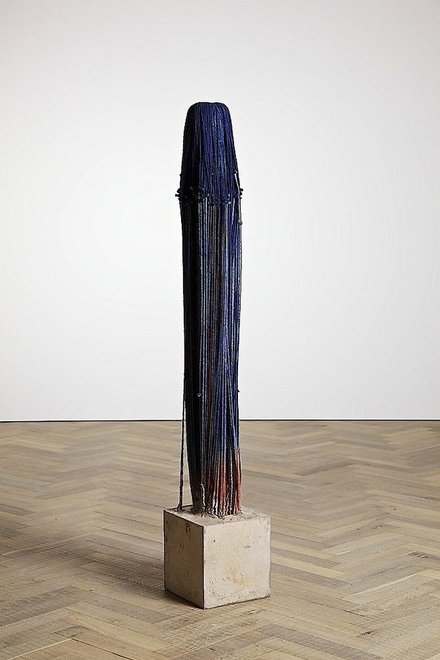
Alexandre da Cunha, BUST XXXV, 2012. Mop, string, and concrete, 48 3/4 x 8 x 7 7/8 inches (123.82 x 20 x 20 cm). Gift of Fotene Demoulas and Tom Coté. Courtesy the artist and Thomas Dane Gallery, London © Alexandre da Cunha
Alexandre da Cunha uses utilitarian objects to mimic and embellish the gestures of historical abstraction. Mops pose on pedestals to impersonate Constantin Brancusi’s columns, baking trays dangle from curtain hooks in imitation of Alexander Calder’s mobiles, and toilet plungers masquerade as precious vases that slyly wink at Marcel Duchamp’s urinal. The concept of the “assisted readymade” Duchamp pioneered in 1913 is the foundation for da Cunha’s playful elevation of prosaic products. As a student, da Cunha was influenced by the modernist architecture of Rio de Janeiro and was educated in the sensuous geometries of Neo-concretism in São Paulo. Although he emigrated to London to pursue graduate work at the Royal College of Art and the Chelsea College of Art, and has lived there ever since, he embraces Brazilian aesthetic strategies of recycling, reuse, and improvisation.
Of the many household items he repurposes—beach towels, skateboards, deck chairs, hockey sticks, canvas awnings, flowerpots, and straw hats—da Cunha works most extensively with mop heads. Bust XXXV is part of his first body of work based on the mop, the series Busts, 2008–12. In these works, long strands of dyed wool are knotted to the ends of upside-down mops, the handles of which are planted in concrete plinths. Da Cunha’s title for the series signals the figurative presence of the mops and links them to a classical genre of sculpture. Mops symbolize cleaning, a process that da Cunha considers meditative and reinvigorating, though their deployment also alludes critically to the labor conditions of domestic and janitorial workers worldwide.
Bust XXXV was acquired from the landmark exhibition Fiber: Sculpture 1960—present at the ICA/Boston, along with works by Josh Faught, Françoise Grossen, and Sheila Hicks, and inscribes the exhibition program within the collection. Bust XXXV has additional resonance with figurative works in the collection by Louise Bourgeois, Rachel Harrison, and Eva Hesse.
2016.12